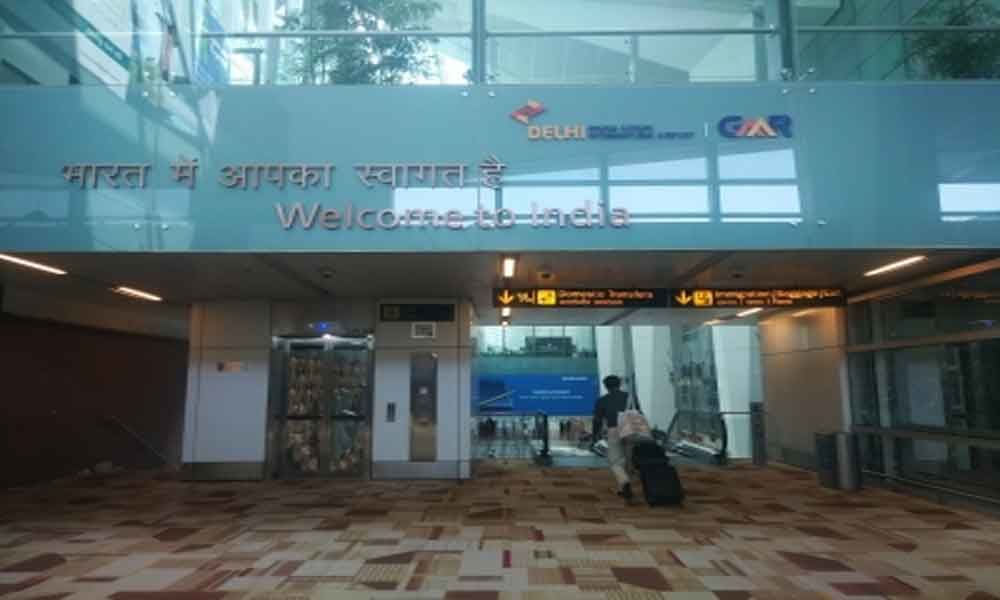Live
- MUDA case: K'taka Lokayukta gets complaint against JD(S) MLA GT Deve Gowda
- ICC Champions Trophy 2025 tour finishes Australian leg
- Japan reports record-high flu cases since 1999
- Central Parliamentary Committee Inspects Polavaram Project Progress
- Anantha Lakshmi Int’l School celebrates Sankranti
- Mukkoti Ekadasi observed with religious fervour
- Officials instructed to solve land issues at once
- Alyssa Healy ready to keep wickets for Australia in Ashes series opener
- Illegal sand mining intensifies along Tungabhadra river
- Rain lashes part of Rajasthan, more in store today
Just In

A series of nine hasta mudras (hand gestures) jutting out of a wall full of copper discs at Terminal 3 of the Indira Gandhi International Airport (IGIA) in New Delhi often leaves visitors in awe.
Jaipur: A series of nine hasta mudras (hand gestures) jutting out of a wall full of copper discs at Terminal 3 of the Indira Gandhi International Airport (IGIA) in New Delhi often leaves visitors in awe.
Ayush Kasliwal, who designed and created the installation in 2010, says: "To welcome the visitors at the airport the Indian way, we were looking for an idea that was synonymous with the Indian culture. The 'hasta mudra' from the Hindu iconography, refer to spirituality and performing arts, including yoga and dance, is something essentially Indian."
A National Institute of Design - Ahmedabad alumnus, Kasliwal has since designed several such artworks, five of which have won Unesco awards for their use of traditional craft traditions and collaboration with local artisans.
A firm believer in the handcrafted legacy of India, Jaipur-based Kasliwal has made a mark on the global map as one of the country's leading design thinkers and practitioners. A furniture designer by profession, he believes in socially conscious and sustainable art and has been advocating women's empowerment as well as the cause of artisans.
Known for developing communities, the young designer is encouraging a new generation of artisans to carry forward their rich legacy of handcrafted skills.
Early this year, Kasliwal designed and curated the India pavilion of international consumer goods fair, Ambiente 2019, in Frankfurt. "With India being the partner country for the fair, the aim was to build credibility for Indian aesthetics and to give the country the intellectual edge of being the creator and owner of an aesthetics, rather than only a manufacturing centre," says Kasliwal.
As expected, the handmade decor of the India pavilion, left visitors from across the world extremely impressed.
At the global platform, he also raised questions on the growing emphasis on mechanising things world over. "Why do we need to mechanise everything, when we have so many hands to create beautiful things?" asks Kasliwal.
The designer believes such global engagements can have a snowball effect, turning our handicrafts into a scalable industry.
"These engagements can get the handmade products industry a long-awaited recognition on world platform. This in turn can help boost the business of craft-based enterprises, giving them a global reach. This is sure to project India as a nation that thinks and believes as it makes for the world," adds Kasliwal.
He also has a few complaints though. "At present, we are busy skilling unskilled hands, without recognising the power of skilled hands. We have the power to create a major handicrafts industry, but only if we have policies to promote our homegrown crafts," he says.
"Handmade products have no regulatory policies. The need of the hour is to have a separate ministry of crafts, which can help frame guidelines for the sector. The Ministry of Textiles, which looks after this segment, does not recognise crafts as a priority. Once we have a ministry, our craft sector can scale new heights," he says.

© 2025 Hyderabad Media House Limited/The Hans India. All rights reserved. Powered by hocalwire.com







